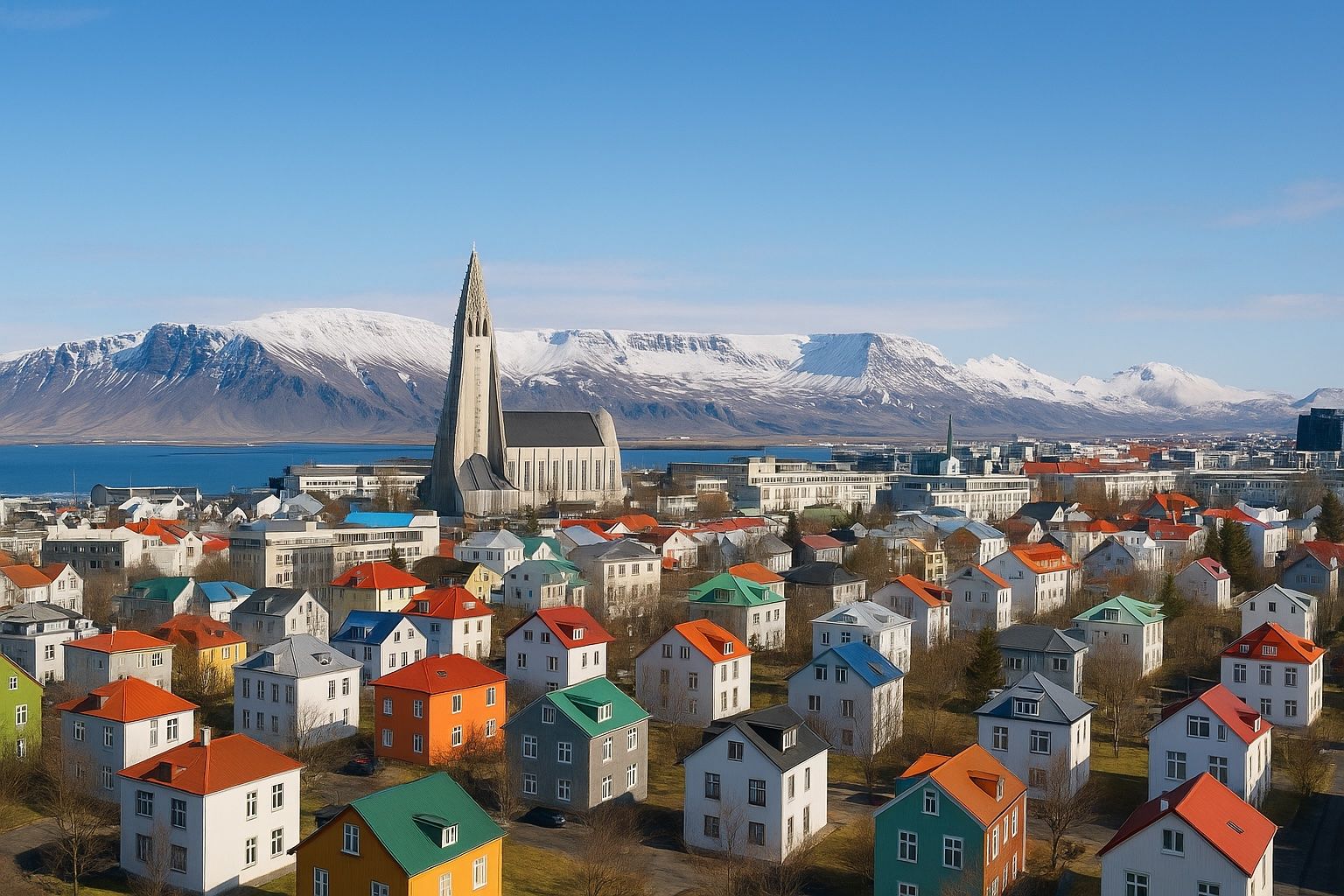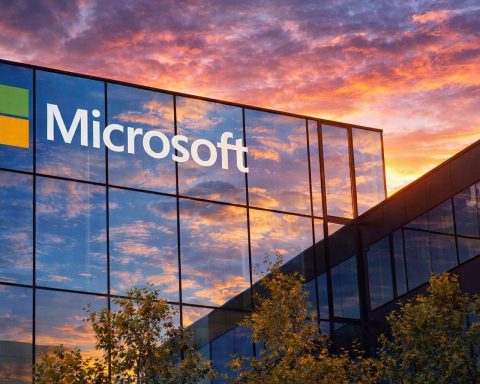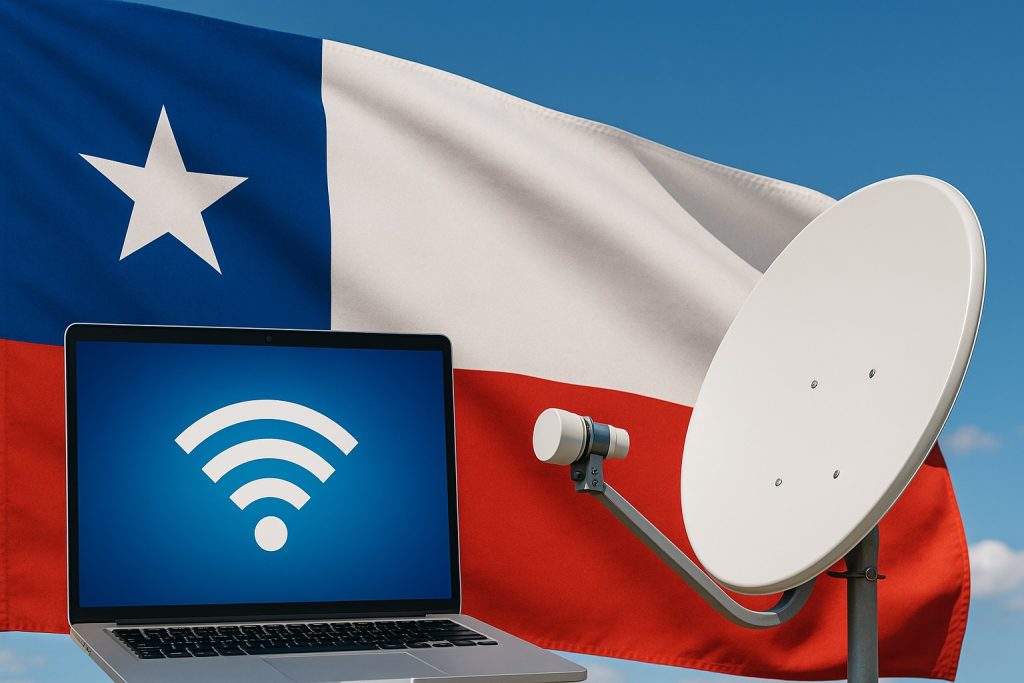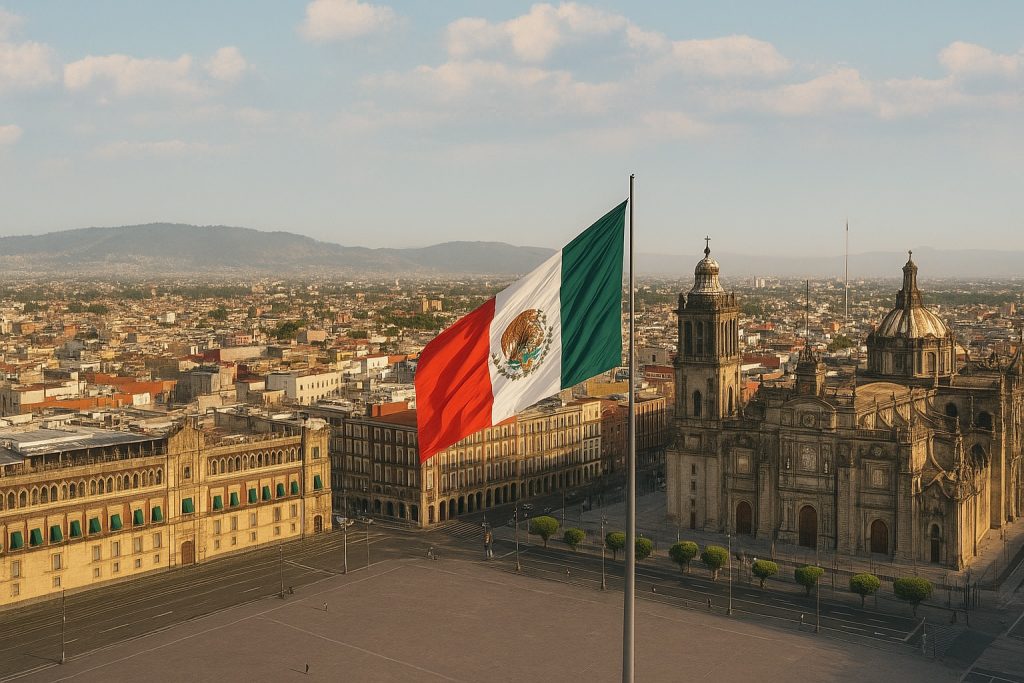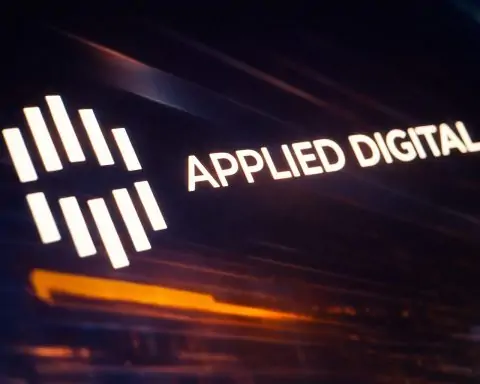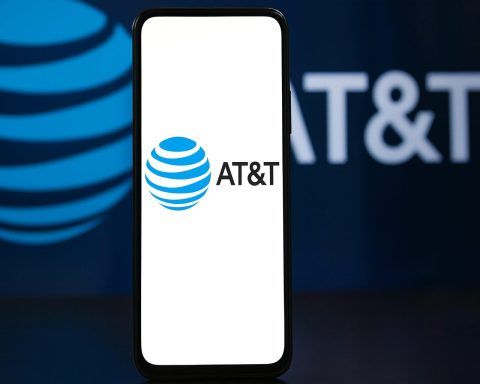- Fixed fiber dominates Iceland’s broadband, with FTTH at 88.7% of fixed lines and over 93% of homes having gigabit-capable fiber, including at least 1 Gbps nationwide and 10 Gbps in most areas.
- Iceland is linked internationally by four submarine cables—FARICE-1, DANICE, Greenland Connect, and IRIS (launched in 2023 to Ireland)—totaling 208.8 Tbit/s of capacity, of which about 3 Tbit/s is currently used.
- Three mobile operators—Síminn, Vodafone Iceland (Sýn), and Nova—provide nationwide 4G/5G, with Nova launching 5G in 2020 and Síminn and Vodafone in 2021.
- By 2023, 5G signals blanket most towns and transit routes across Iceland, with widespread 4G/5G coverage along the coast where most people live.
- In 2022 there were over 521,000 active mobile subscriptions in a country of about 370,000 people, plus 64,000 data-only 4G/5G subscriptions.
- The Ísland Ljóstengt program (2016–2022) connected about 5,500 rural locations with FTTH, reducing legacy ADSL to roughly 1.3% of connections by 2022.
- In 2024 the government designated Neyðarlínan as the universal service provider for telecom, replacing Míla, with a goal of 100% fiber coverage by 2026.
- As of early 2024 Iceland ranked 6th globally for average fixed broadband speeds at about 242 Mbps, rising to roughly 282 Mbps by January 2025.
- Starlink became available in February 2023, delivering 150–200 Mbps downloads and 60–70 ms latency in Iceland, used by remote operators and as emergency backup.
- Basic home internet costs around 5–6 thousand ISK per month (~$40) with unlimited data and no data caps since 2017, reflecting broad affordability.
Iceland may be a small, remote island in the North Atlantic, but it boasts one of the world’s most advanced internet ecosystems. Virtually the entire population is online – over 99% of Icelanders use the internet [1] – and they enjoy some of the fastest connections on Earth. This report explores Iceland’s internet infrastructure from ultra-fast fiber networks to far-reaching mobile coverage, detailing key providers, speeds, accessibility, government initiatives, satellite options, and how Iceland compares globally (and to its Nordic neighbors).
Iceland’s Internet Infrastructure Overview
Broadband and Fiber Backbone: Iceland has aggressively built out fiber-optic broadband across the country. Full-fiber (FTTH) connections are now the norm, comprising about 88.7% of all fixed broadband lines [2]. As a result, over 93% of Icelandic homes have access to gigabit-capable fiber [3] [4]. In practice, at least 1 Gbps download speeds are available to all residents, with 10 Gbps service offered in most areas [5]. This pervasive fiber network puts Iceland at the top of Europe for fiber penetration – it became the #1 country in Europe for fiber-to-the-premises (FTTP) uptake in 2020 [6]. The fiber backbone (operated largely by Míla and Ljósleiðarinn) stretches across communities island-wide, ensuring that even distant towns are connected via high-capacity links. Internationally, Iceland is linked by four submarine fiber-optic cables to Europe and North America, with a hefty 208.8 Tbit/s of total international bandwidth capacity as of 2023 [7] [8]. (For perspective, Iceland currently uses only a small fraction of that capacity – about 3 Tbit/s – leaving enormous room for growth [9].) These undersea cables (such as FARICE-1, DANICE, Greenland Connect, and the new 2023 IRIS cable to Ireland) provide redundancy and fast global transit, which has also attracted data centers to Iceland [10].
Figure: Map of Iceland’s fiber-optic network routes (major trunk lines), according to the national telecom database [11]. The fiber backbone connects virtually all populated areas, enabling nationwide high-speed broadband.
Mobile Networks (4G/5G): Iceland’s mobile telecom infrastructure is equally robust. Three main operators – Síminn, Vodafone Iceland (Sýn), and Nova – provide mobile voice and data services, with competitive overlap in coverage. The country has had nationwide 3G/4G for years and was an early adopter of 5G. Nova launched the first 5G service in 2020, and Síminn and Vodafone followed in 2021, aiming for rapid rollout [12]. Today, 4G and 5G coverage is extensive across populated areas [13]. All three carriers report strong coverage around the coastal regions where most Icelanders live (coverage maps show nearly blanket 4G/5G along the coastlines) and somewhat spottier signal in the uninhabited highland interior. In fact, Iceland’s geography means the vast majority of people reside in cities and towns around the coast, allowing operators to cover over 99% of the population even if the rugged central highlands have no signal [14]. Older networks (2G/3G) are being retired by 2025 as the focus shifts entirely to 4G LTE and 5G services [15]. Mobile internet speeds in Iceland are among the fastest in the world – median mobile download speed is about 214 Mbps, placing Iceland in the global top ten for mobile data speeds [16]. With 5G expansion, average mobile bandwidth continues to climb. As of 2022 there were over 521,000 active mobile subscriptions (in a country of ~370,000 people), indicating many users have multiple devices or data-only SIMs [17]. An additional 64,000 data-only 4G/5G subscriptions serve laptops, tablets, IoT devices, and home broadband substitutes (common for summer houses and remote areas) [18]. This high mobile penetration (about 141% relative to population) underscores how accessible wireless connectivity is in Iceland [19].
Rural Connectivity: Reaching the most remote farms and villages has been a priority. While the major towns now enjoy fiber, some smaller or isolated settlements initially had to rely on VDSL or even older ADSL lines. To close these gaps, the government launched “Ísland Ljóstengt” (Iceland Optical Connected) – a program (2016–2022) that subsidized fiber rollout to sparsely populated rural areas [20]. This initiative connected around 5,500 rural locations with FTTH that otherwise would not be economical to serve [21]. Thanks to such efforts, by 2022 only about 1.3% of connections (roughly 1,800 remote homes) were still on legacy ADSL under 10 Mbps [22]. Many of those remaining have at least VDSL or fixed-wireless options. The government isn’t stopping there – in 2024 it set a goal of 100% of homes and businesses having fiber broadband by 2026, backed by new grants to extend fiber into the last outlying communities [23]. In practice, this means even the most far-flung farm or fishing village should soon have gigabit internet access. For the truly remote homesteads that are off the grid, fixed 4G/5G wireless and emerging satellite options are filling in the gaps (see Satellite Internet below). The bottom line is that geography is no longer a barrier: whether in downtown Reykjavík or on a distant fjord, Icelanders can get online with broadband speeds. It’s no surprise that as of 2021, 98% of Icelandic households had internet access at home [24] – a level of connectivity on par with the very highest in Europe.
To summarize the types of internet access in use, the vast majority of Icelandic subscribers are on fiber, with DSL and wireless now rare:
| Connection Type | Share of Broadband Lines (End of 2023) |
|---|---|
| Fiber (FTTH) | 88.7% [25] |
| VDSL (FTTC copper) | 10.3% [26] |
| ADSL (legacy copper) | 0.9% [27] |
| Fixed Wireless | 0.2% [28] |
This heavy skew toward fiber illustrates Iceland’s leap to next-gen infrastructure. Meanwhile, service quality is uniformly high – over 97.9% of fixed subscriptions deliver at least 30 Mbps download speeds [29], and as noted, the majority are getting 500 Mbps to multi-gigabit speeds [30]. Indeed, nearly half of connections advertise 1 Gbps or above [31]. Even winter storms (common in Iceland) rarely disrupt connectivity for more than brief periods, though severe weather can cause isolated power outages that temporarily knock out local internet until power is restored [32].
Key ISPs and Telecom Providers
Iceland’s telecom market, though small, is competitive and progressive. The industry was liberalized years ago, breaking the monopoly of the former state telco Síminn. Today three companies dominate retail internet services: Síminn, Vodafone Iceland (branded as Sýn), and Nova [33]. Smaller ISPs like Hringdu and regional operators account for the remaining market share [34]. Síminn (the incumbent) remains the largest provider, but Nova – originally a mobile-only upstart – has grown rapidly and now challenges the big two in both mobile and fixed broadband [35]. In fact, Nova has become the leading player in the mobile market by user numbers, while also expanding into fiber broadband offerings [36]. Vodafone Iceland has rebranded as Sýn and continues to hold a strong second-place position across multiple services. The table below shows the top ISPs and their market shares:
| ISP (Provider) | Fixed Internet | IPTV | Landline Phone | Market Share (2021) |
|---|---|---|---|---|
| Síminn | Yes | Yes | Yes | 45.4% [37] |
| Vodafone (Sýn) | Yes | Yes | Yes | 24.2% [38] |
| Nova | Yes | No | No | 17.9% [39] |
| Hringdu | Yes | No | Yes | 10.1% [40] |
| Others (combined) | Mostly data | Varies | Varies | 2.4% [41] |
Síminn historically was the state telecom (spun off from the post office), and it still operates extensive infrastructure. In recent years, Síminn separated its network assets into a company called Míla, which now runs the national fiber/copper infrastructure (Míla was even sold to an investor in 2022, further opening the market) [42]. Míla is the main wholesale network provider, offering access to its fiber-to-the-home network on a neutral basis to retail ISPs. Meanwhile Ljósleiðarinn (Reykjavík Fiber Network), originally a municipal network in the capital, has grown into the second-largest fiber network operator, covering most of the southwest and several regional towns with its own fiber lines [43]. Other local networks (e.g. Tengir in the north, Snerpa in the Westfjords) fill in regional gaps [44] [45]. This open-access model means that in many areas customers can choose an ISP (Síminn, Nova, etc.) regardless of whether the line to their house is owned by Míla or another fiber operator. It fosters competition in services even if infrastructure is shared.
Overall, Iceland’s ISP market shows effective competition both in mobile and broadband, which has kept prices relatively reasonable and quality high [46]. Prices for home internet tend to range from around 5,000 ISK ($35) for basic plans to 10,000+ ISK ($70+) for top-tier gigabit packages, which – given Iceland’s high income levels – makes internet access widely affordable (around or below 1% of median household income) [47] [48]. Furthermore, all three major ISPs bundle services like IPTV and phone with broadband, and there are no data caps on fixed-line plans, so Icelanders can use the internet freely. Public Wi-Fi is also abundant (cafes, public buildings, even buses), contributing to near-universal connectivity for residents and visitors [49] [50].
It’s worth noting the regulatory environment: Iceland’s Electronic Communications Office (ECOI) (formerly Post- and Telecom Admin) oversees the sector. In 2024, the government designated Neyðarlínan (the state-owned emergency communications company) as the universal service provider for telecom, replacing Míla in that role [51]. This means the state ensures basic telephony and internet services are available to all citizens at an affordable price, a safety net in case the market doesn’t reach the final remote users. In practice, however, the combination of private investment and targeted government funding has already delivered connectivity to essentially everyone.
Blazing Fast Speeds and Global Rankings
Iceland’s internet speeds are world-class, reflecting its all-fiber network and modern mobile tech. For fixed broadband, Iceland consistently ranks near the very top globally. As of early 2024, it was 6th in the world for average download speed, at about 242 Mbps per Speedtest.net data [52]. By January 2025, the country’s average fixed speed had risen further to roughly 282 Mbps, placing it around 5th fastest worldwide (only Singapore, UAE, Hong Kong, and France were slightly ahead) [53] [54]. In Europe, Iceland is a clear leader – for example, its 281.95 Mbps average edges out Denmark (247.6 Mbps) and is far above the European average [55] [56]. Median speeds tell a similar story: with a median ~214 Mbps, Iceland is in the global top ten for broadband performance [57]. These figures confirm that what used to be “future” internet speeds (hundreds of Mbps) are now everyday reality in Iceland. The broad availability of gigabit plans means many users get even higher real-world performance; over 73% of connections advertise 500 Mbps or above [58]. Upload speeds are also excellent (often symmetric on fiber), making Island a haven for heavy data users, streamers, and businesses alike.
Mobile speeds are also impressive. On 5G networks, users in Reykjavík and other cities commonly see downloads well over 200 Mbps. Overall, Iceland’s median mobile download speed (~129–214 Mbps in reports) puts it among the fastest mobile internet countries (often ranked 5th–10th globally) [59] [60]. Even 4G LTE speeds are very solid (routinely tens of Mbps), thanks to uncongested networks and extensive 4G coverage on lower frequency bands that reach rural areas. For context, global average mobile speed is only about 63 Mbps [61] – Iceland’s mobile internet is several times faster than that. Latency is low on domestic networks (crucial for online gaming or video calls), and the multiple submarine cables keep international latency reasonable (London <20 ms, New York ~60 ms). With 2G and 3G being phased out by 2025, carriers are refarming spectrum to 4G/5G, which will further boost capacity and speeds [62]. All operators have been investing in 5G NR coverage; Síminn partnered with Ericsson to deploy 5G nationwide by end of 2022 [63], and as of 2023 5G signals blanket most towns and transit routes. By around 2021, it was reported about 50% of the population had 5G coverage and that share has grown substantially since [64]. In short, whether via fiber or mobile, Icelanders experience fast and reliable internet connectivity that outpaces much of the world.
To illustrate how far ahead Iceland is in fixed broadband, consider that 97.9% of subscribers enjoy at least 30 Mbpsdownlink [65] (nearly everyone, basically), and over half have 1 Gbps available [66]. In contrast, many developed countries are still working toward universal 30 Mbps or 100 Mbps goals. Iceland already treats 100 Mbps as a baseline and is charging toward multi-gigabit territory. The country’s ambitious target to provide 100 Mb/s or more to 99.9% of the population by 2021 was effectively achieved [67] [68] – an “ambitious target by international standards” that Iceland met through rapid fiber deployment and upgrades in even remote exchanges [69]. Now the bar is set even higher with plans for 100% gigabit fiber coverage.
Accessibility and Affordability
Internet access in Iceland is not just fast – it’s also widely accessible and relatively affordable, resulting in a highly inclusive digital society. As noted, essentially all households can get online, and almost everyone chooses to do so (internet use is ~99% of the population [70]). There are few if any “digital divide” issues in terms of connectivity availability. Even lower-income or rural households have options thanks to universal service measures and subsidized network rollouts. For those in remote areas, the government’s Telecommunications Fund and Ljóstengtprogram covered installation costs of fiber or wireless links [71]. Public institutions like libraries, schools, and service centers all provide internet access points, ensuring that citizens without a home connection (a very small minority, often by personal choice) can still log on. Public Wi-Fi is common in urban areas, and mobile data plans are affordable enough that most people use smartphones for internet on the go [72].
In terms of pricing, while Iceland’s overall cost of living is high, broadband prices are comparable to European norms. Basic home internet packages (with unlimited data) can be found for around 5–6 thousand ISK per month (≈ $40), which typically includes ~100 Mbps speeds. The government monitors retail prices to ensure they remain fair and has intervened in the past via the regulatory agency to lower wholesale costs on rural circuits [73]. Additionally, since 2017 Iceland has had no internet data caps or usage-based throttling on mainstream broadband – truly unlimited service is the standard, which encourages people to maximize the internet’s benefits (for entertainment, education, e-health, etc.) without worry of overage fees. Overall, surveys show Icelanders are highly satisfied with their internet quality and access. With near-total coverage and steadily improving performance, the internet is essentially ubiquitous in everyday Icelandic life, from banking and government e-services to streaming TV and connecting with the world.
Government Policy and Digital Initiatives
The Icelandic government has played a proactive role in the nation’s connectivity success. A clear national digital strategy focused on broadband as critical infrastructure has guided policy for the past decade. One flagship effort was the “Iceland Optical Connected” initiative, which aimed to deliver at least 100 Mbps to all citizens by 2020 [74]. Through this program and follow-on phases, the state allocated grants (over ISK 400 million in 2020, plus 180 million in 2021) to telecom operators and municipalities to extend fiber to areas where private investment alone fell short [75] [76]. This public-private partnership model proved effective in achieving near-universal high-speed coverage. By 2024, the government set a new goal (as mentioned earlier) to reach full fiber coverage by 2026, using targeted subsidies for the last few rural towns without fiber [77]. The Telecommunications Fund (Fjarskiptasjóður) has been instrumental in financing these rural broadband projects [78].
Regulation has also ensured a level playing field. The telecom regulator (ECOI) enforced local loop unbundling and open access on Míla’s network, so that new ISPs could compete using the incumbent’s infrastructure. It also managed spectrum auctions for 4G and 5G in a way that all three mobile operators obtained licenses to deploy nationwide [79]. The result is that even sparsely populated regions often have a choice of providers or technologies for internet access. Digital inclusion programs have likewise addressed usage and skills – for example, initiatives to help senior citizens gain digital literacy and to ensure public websites are accessible in Icelandic (and English) for all users. However, given Iceland’s extremely high uptake, the digital divide is more about usage quality (e.g. older people using only basic services) than about lack of access.
Another aspect of policy is resilience and security. Iceland has just one Internet Exchange Point (RIX in Reykjavík) to keep domestic traffic local [80], and the government works with operators to ensure redundancy in critical infrastructure (the multiple submarine cables, backup power for telecom towers, etc.). After a 2019 storm knocked out some communications in the far east for a short time [81], efforts were made to improve backup links to those areas. Cybersecurity is handled by CERT-IS, a national team that coordinates responses to cyber threats [82]. All these measures align with Iceland’s view of the internet as vital infrastructure.
Finally, Iceland’s membership in the EU/EEA frameworks (though not an EU member state, it adheres to EU telecom regulations via the EEA) means it follows European standards for net neutrality, roaming, and data privacy. For instance, EU’s “Roam Like at Home” policy applies, so Icelanders traveling in Europe use mobile data at domestic rates and vice versa [83]. This international cooperation further integrates Iceland’s internet with its neighbors, to the benefit of consumers.
Satellite Internet for Remote Areas
Even with fiber and mobile networks reaching nearly everyone, Iceland has also embraced satellite internet as a new frontier – particularly for those ultra-remote locations and niche use cases. In February 2023, SpaceX’s Starlink satellite broadband service became available in Iceland [84]. Starlink’s constellation of low-earth-orbit satellites can beam high-speed internet to a small dish anywhere with a clear view of the sky. This is a game-changer for places like mountain cabins, research outposts, ships at sea, or far-flung farms where laying fiber or maintaining cell towers is impractical. Early adopters in Iceland reported Starlink download speeds in the 150–200 Mbps range, which is on par with urban broadband. Starlink began service in Iceland without a local ground station, meaning user traffic currently routes via gateways in other countries (which adds a bit of latency) [85]. Even so, latency around ~60-70 ms is a huge improvement over traditional geostationary satellite internet and quite usable for most applications.
Adoption of Starlink in Iceland is still limited – after all, only a tiny fraction of the population lacks decent landline or cellular internet. But for that fraction, Starlink is providing connectivity where nothing else can. For example, remote tourism operators (like highland tour camps) and some fishing vessels now use Starlink to stay connected. The presence of a satellite option also introduces more redundancy into the national network. In event of a natural disaster that cuts off terrestrial links in a region (say, a volcanic eruption or glacial flood taking out lines), Starlink dishes could serve as emergency backup internet links to keep communities online. Besides Starlink, other satellite services (Inmarsat, Iridium, etc.) have long been accessible in Iceland, but they were narrowband and extremely expensive – useful mainly for basic email or phone in emergencies. Starlink’s arrival in 2023 marked the first affordable, high-bandwidth satellite internetavailable to ordinary consumers in Iceland. As satellite constellations expand, we can expect even the last “blackout” zones on Iceland’s map to vanish. The government has welcomed these services as complementary to the terrestrial networks, ensuring everyone, everywhere can have internet access if they want it.
Innovations and Future Developments
Iceland’s internet ecosystem continues to evolve with an eye on future technology and demands. Some key developments and trends shaping the future include:
- Complete Fiber Coverage & Copper Shutdown: Within the next couple of years, Iceland is on track to achieve 100% fiber broadband coverage to homes and businesses [86]. This will likely coincide with the retirement of copper networks (the old telephone lines and DSL). Síminn/Míla have already begun phasing out the legacy PSTN and older DSLAMS [87] [88]. By the mid-2020s, Iceland will be one of the few countries where the entire fixed access network is fiber-optic. This sets the stage for offering multi-gigabit standard plans nationwide and simplifies network maintenance (no more fixing old copper lines). It also future-proofs the country for decades, as fiber can handle increasing data loads.
- Next-Gen Mobile (5G and beyond): With 5G now mainstream in Iceland, operators are enhancing these networks and preparing for 6G down the line. 5G has opened up new possibilities such as fixed wireless access (home broadband via 5G routers) which some rural users use instead of waiting for fiber. The carriers are also leveraging 5G for IoT (Internet of Things) deployments – for instance, smart grid sensors and remote monitoring in Iceland’s geothermal power plants. The high penetration of smartphones and 5G means Icelanders will be quick to adopt future mobile innovations. By shutting down 2G/3G, operators free up spectrum for expanded 5G capacity and eventually 6G trials (expected in the 2030s). Given Iceland’s tech-savvy population, we can expect strong early adoption of any new wireless tech that improves connectivity.
- International Connectivity & Data Centers: The completion of the new IRIS submarine cable to Ireland in 2023 bolstered Iceland’s external connectivity, adding a third route to Europe (alongside FARICE-1 to Scotland and DANICE to Denmark) [89]. Additionally, a branch of the Greenland Connect cable links Iceland westward via Greenland to North America [90]. These diversified links make Iceland an even more attractive location for data centers and cloud services. In recent years, companies like Verne Global and atNorth have built large data centers in Iceland to capitalize on its renewable energy and cool climate, and of course, robust internet pipelines. Most of Iceland’s growth in international bandwidth usage is driven by these data centers, as they serve global clients from Iceland [91]. The trend of Iceland as a Nordic data hub is likely to continue, with new projects potentially linking Iceland to other networks (there have been proposals to connect Iceland directly to North America with a future cable, though nothing confirmed yet). The government is supportive of such investments, seeing digital infrastructure as the “new fishing industry” – a pillar of the economy.
- Cutting-Edge Tech Trials: Despite its size, Iceland isn’t shy about experimenting with new networking technologies. The country was among the first to deploy 10 Gbps residential broadband in Europe – both Míla and Ljósleiðarinn offer 10 Gbps fiber plans in select areas today [92] [93]. There’s ongoing discussion of implementing IPv6 nationwide (Iceland has high IPv6 adoption by ISP networks, aligning with global standards). Icelandic researchers have also looked into Arctic satellite communications and high-altitude platforms to extend coverage to research stations on glaciers or vessels at sea. Additionally, telecom companies are improving network resilience using innovations like microwave radio backups for remote cell towers and experimenting with edge computing nodes in rural exchanges to lower latency for cloud services. All these efforts aim to keep Iceland on the cutting edge of connectivity.
In summary, the trajectory for Iceland’s internet is ever upward: faster speeds, greater reliability, and connectivity literally everywhere – all while being powered by 100% renewable energy (a unique aspect, as the networks run on Iceland’s geothermal and hydro power). Few places in the world will be as ready for the data-driven future as Iceland.
Global and Nordic Comparison
How does Iceland stack up against global standards and its Nordic neighbors? In short, exceptionally well. Iceland often tops international comparisons for internet usage, speed, and penetration. For example, Iceland’s 99%+ internet adoption rate is basically the highest in the world, on par with fellow Nordic countries like Norway (which also reports ~99% usage) [94] [95]. In terms of broadband speed, Iceland outperforms all other Nordics: Denmark, Sweden, Finland, and Norway all have lower average speeds (for instance, Sweden’s average download is around 175 Mbps vs. Iceland’s ~282 Mbps) [96] [97]. This is largely thanks to Iceland’s leap to fiber – whereas Sweden and Norway still have significant portions of users on cable or DSL, nearly 85–93% of Icelandic connections are pure fiber [98] [99]. In fact, an OECD study in 2023 showed Iceland among just a few countries (along with Korea and Japan) with fiber making up over 80% of broadband subscriptions [100]. Iceland also has a higher proportion of gigabit subscribers than most countries.
When comparing mobile networks, all Nordic countries have extensive 4G/5G coverage and high usage. Iceland’s advantage is that its small population and geography allowed very rapid 5G rollout and less congestion. Norway and Finland have slightly lower population density challenges but still not as centralized as Iceland’s coastal population; nonetheless, those countries also report high mobile penetration and are close in mobile speed rankings (in some reports Norway actually led in 2021 5G speeds, but Iceland has been catching up) [101] [102]. In terms of pricing, Nordic countries generally have affordable broadband relative to income – Iceland is in line with Norway/Denmark on that front, though perhaps a bit pricier than Sweden or Finland for entry-level plans. However, differences are minor when adjusted for income. All Nordics, including Iceland, uphold net neutrality and have strong policies for universal service, so basic access is not a problem in any of these countries.
One area where Iceland uniquely shines is the sheer pervasiveness of high-speed access. While, say, rural Lapland in Finland or northern Norway might still lack fiber (with some remote communities on radio links), Iceland’s aggressive programs mean even the countryside is getting fiber or high-speed wireless. The commitment to 100% gigabit by 2026 is a bolder target than most countries have set. Culturally, Icelanders are tech-forward – social media and internet banking usage rates are among the highest globally, comparable to or exceeding other Nordics [103]. Essentially, Iceland is a case study of how a small nation can leverage policy and technology to vault into the top tier of digital nations. It consistently punches above its weight: despite its tiny population, Iceland is a global leader in internet connectivity and usage.
In conclusion, Iceland’s internet access story is one of ambition and achievement. From laying fiber across a frozen volcanic island, to lighting up one of the world’s fastest broadband networks, to ensuring that virtually every citizen can benefit – Iceland has built an internet ecosystem that rivals (and often tops) that of far larger countries. As the nation known as the “land of fire and ice” proves, even the most remote places can become hyper-connected in the digital age. Iceland’s success provides a roadmap for how smart infrastructure investment, competition, and forward-looking policy can yield a truly inclusive, high-performance internet for all. [104] [105]
References
1. en.wikipedia.org, 2. en.wikipedia.org, 3. en.wikipedia.org, 4. en.wikipedia.org, 5. en.wikipedia.org, 6. www.globenewswire.com, 7. en.wikipedia.org, 8. en.wikipedia.org, 9. en.wikipedia.org, 10. en.wikipedia.org, 11. commons.wikimedia.org, 12. en.wikipedia.org, 13. freedomhouse.org, 14. www.lavacarrental.is, 15. en.wikipedia.org, 16. worldpopulationreview.com, 17. en.wikipedia.org, 18. en.wikipedia.org, 19. freedomhouse.org, 20. en.wikipedia.org, 21. en.wikipedia.org, 22. en.wikipedia.org, 23. en.wikipedia.org, 24. freedomhouse.org, 25. en.wikipedia.org, 26. en.wikipedia.org, 27. en.wikipedia.org, 28. en.wikipedia.org, 29. freedomhouse.org, 30. en.wikipedia.org, 31. en.wikipedia.org, 32. freedomhouse.org, 33. en.wikipedia.org, 34. en.wikipedia.org, 35. www.globenewswire.com, 36. www.globenewswire.com, 37. en.wikipedia.org, 38. en.wikipedia.org, 39. en.wikipedia.org, 40. en.wikipedia.org, 41. en.wikipedia.org, 42. www.globenewswire.com, 43. en.wikipedia.org, 44. en.wikipedia.org, 45. en.wikipedia.org, 46. www.globenewswire.com, 47. shrine-dev-node02.catalyst.harvard.edu, 48. www.camperrentaliceland.com, 49. www.lavacarrental.is, 50. www.lavacarrental.is, 51. en.wikipedia.org, 52. en.wikipedia.org, 53. en.wikipedia.org, 54. en.wikipedia.org, 55. en.wikipedia.org, 56. en.wikipedia.org, 57. worldpopulationreview.com, 58. en.wikipedia.org, 59. worldpopulationreview.com, 60. worldpopulationreview.com, 61. worldpopulationreview.com, 62. en.wikipedia.org, 63. www.globenewswire.com, 64. freedomhouse.org, 65. freedomhouse.org, 66. en.wikipedia.org, 67. www.globenewswire.com, 68. freedomhouse.org, 69. www.globenewswire.com, 70. en.wikipedia.org, 71. en.wikipedia.org, 72. www.lavacarrental.is, 73. www.globenewswire.com, 74. freedomhouse.org, 75. freedomhouse.org, 76. freedomhouse.org, 77. en.wikipedia.org, 78. www.globenewswire.com, 79. freedomhouse.org, 80. en.wikipedia.org, 81. freedomhouse.org, 82. en.wikipedia.org, 83. www.lavacarrental.is, 84. en.wikipedia.org, 85. en.wikipedia.org, 86. en.wikipedia.org, 87. www.globenewswire.com, 88. www.globenewswire.com, 89. en.wikipedia.org, 90. en.wikipedia.org, 91. en.wikipedia.org, 92. en.wikipedia.org, 93. en.wikipedia.org, 94. en.wikipedia.org, 95. explodingtopics.com, 96. en.wikipedia.org, 97. en.wikipedia.org, 98. www.oecd.org, 99. en.wikipedia.org, 100. www.oecd.org, 101. worldpopulationreview.com, 102. worldpopulationreview.com, 103. grapevine.is, 104. en.wikipedia.org, 105. www.globenewswire.com
